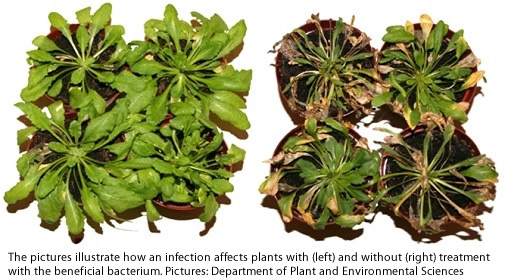CROP BIOTECH UPDATE
---------------------------------------------------------------------------
A weekly summary of world developments in agri-biotech for developing countries, produced by the Global Knowledge Center on Crop Biotechnology, International Service for the Acquisition of Agri-biotech Applications SEAsiaCenter (ISAAA)
---------------------------------------------------------------------------
March 23, 2016
In This Week’s Issue:
News
Americas
• Plants' Ability to Adapt Changes Conventional Knowledge on Climate Change, Says New Study
Asia and the Pacific
• Australia's OGTR Authorizes Commercial Release of GM HT Canola
• Biologists Identify Plant Clock Genes Regulating Circadian Rhythm
Europe
• Plants Found to Host Beneficial Fungi When Required
• Researchers Discover Microbes Use Plant Hormones to Protect Plants
Research
• MicroRNA-Dependent Gene Regulatory Network for Leaf Senescence in Maize
• Expression of WRINKLED1 in Potato Increases Triacylglycerol Content in Tubers
• Cystatin Restores Fertility in Cysteine Protease-Induced Male Sterile Tobacco
Beyond Crop Biotech
• Researchers Generate Whole Genome Map of Fruit Fly Genetic Recombination
• Study Details How Plants Create Anticancer Compounds
• Human Growth Factor Expressed in Transgenic Insect
Announcements
• 3rd Plant Genomics Congress: Asia
• 5th International Conference and Exhibition on Metabolomics
----
NEWS
----
Americas
PLANTS' ABILITY TO ADAPT CHANGES CONVENTIONAL KNOWLEDGE ON CLIMATE CHANGE, SAYS NEW STUDY
 As temperatures increase, plants speed up their respiratory metabolism, leading to elevated carbon release and making forests around the world a carbon source. However, a new study at the University of Minnesota on more than 1,000 young trees has found that plants adjust or acclimate to a warmer climate and may release only one-fifth as much additional carbon dioxide than scientists previously believed.
As temperatures increase, plants speed up their respiratory metabolism, leading to elevated carbon release and making forests around the world a carbon source. However, a new study at the University of Minnesota on more than 1,000 young trees has found that plants adjust or acclimate to a warmer climate and may release only one-fifth as much additional carbon dioxide than scientists previously believed.
The study was based on B4Warmed, a five-year project that simulated the effects of climate change on 10 boreal and temperate tree species growing in an open-air setting in 48 plots in two forests in northern Minnesota. The researchers increased temperatures at the test plots by 3.4 degrees C, an increase that is likely to happen by the end of the 21st century, and learned that plants grown and measured at those higher temperatures increased their leaf respiration by an average 5 percent, compared to plants in ambient temperatures. If the plants were not acclimated to the higher temperatures, their respiration would have increased by 23 percent over the plants in ambient temperatures.
For more details, read the news release at the University of Minnesota website.
Asia and the Pacific
AUSTRALIA'S OGTR AUTHORIZES COMMERCIAL RELEASE OF GM HT CANOLA
 Australia's Office of the Gene Technology Regulator (OGTR) has issued a license in response to application DIR 138 from Bayer CropScience, authorizing the commercial release of canola genetically modified (GM) for dual herbicide tolerance and to facilitate production of the GMOs. The release is authorized to take place throughout Australia. The GM canola and products derived from the GM canola may enter general commerce, including use in human food and animal feed. Food Standards Australia New Zealand (FSANZ) has approved the use in food of material derived from this GM canola.
Australia's Office of the Gene Technology Regulator (OGTR) has issued a license in response to application DIR 138 from Bayer CropScience, authorizing the commercial release of canola genetically modified (GM) for dual herbicide tolerance and to facilitate production of the GMOs. The release is authorized to take place throughout Australia. The GM canola and products derived from the GM canola may enter general commerce, including use in human food and animal feed. Food Standards Australia New Zealand (FSANZ) has approved the use in food of material derived from this GM canola.
The decision to issue the license was made after consultation on the Risk Assessment and Risk Management Plan (RARMP) with the public, State and Territory governments, Australian Government agencies, the Minister for the Environment, the Gene Technology Technical Advisory Committee and local councils, as required by the Gene Technology Act 2000 and the corresponding State and Territory legislation.
The final RARMP, as well as its summary, a set of Questions and Answers on this decision, and a copy of the license are available online from the DIR 138 page of the OGTR website.
BIOLOGISTS IDENTIFY PLANT CLOCK GENES REGULATING CIRCADIAN RHYTHM
 A team of biologists at Nagoya University's Institute of Transformative Bio-Molecules (ITbM) led by Narihito Nakamichi has uncovered that the clock genes produced by plants during the evening are regulated by clock proteins produced in the morning.
A team of biologists at Nagoya University's Institute of Transformative Bio-Molecules (ITbM) led by Narihito Nakamichi has uncovered that the clock genes produced by plants during the evening are regulated by clock proteins produced in the morning.
During the afternoon, plants ready themselves for the cold temperatures that follow sunset. In this manner, plants use their biological clock to respond beforehand to the changes in their surrounding environment that are caused by variation in time. "Since 2011, we have been trying to find the key factor that regulates the expression of the gene that is transcribed during the afternoon," says Nakamichi. The group used PSEUDO-RESPONSE REGULATOR 5 (PRR5), which is a clock gene of the model plant, Arabidopsis thaliana.
According to Nakamichi, they believed that CCA1, a clock protein generated during sunrise, binds to a specific DNA sequence involved in the expression of the target gene PRR5. They collected the CCA1 protein bound to DNA using Chromatin immunoprecipitation (ChIP), and analyzed the DNA sequence by rapid DNA sequencing. They were able to identify that the PRR5 gene appears in the regulatory region at a high frequency, and data suggested that the CCA1 protein directly acts towards the regulatory region of the PRR5 gene and has a major effect on it.
The research group also found the target DNA region of the CCA1 clock protein in the plant cell's chromosome. "We found many genes that are expressed in the evening nearby the DNA region that CCA1 binds to," explains Nakamichi. Some of these genes are responsible for the plant's responses to drought stress, transmission of the signals from the plant hormone, abscisic acid, regulation of the opening and closing of stomata, and production of wax. "The results of our studies suggest that the CCA1 protein induces these biological processes to occur at a specific time during the evening."
For more details, read the research highlights at the Nagoya University website.
Europe
PLANTS FOUND TO HOST BENEFICIAL FUNGI WHEN REQUIRED
Scientists have believed for a long time that the role of plant immune system was only to distinguish between friend and foe and to fend off pathogens, but it is also involved in accommodating beneficial microorganisms in the plant when required. Researchers from the Max Planck Institute for Plant Breeding Research in Cologne, Germany in collaboration with an international consortium of other laboratories discovered this relationship between the model plant Arabidopsis thaliana and the fungus Colletotrichum tofieldiae. The plant tolerates the fungus when it needs help in obtaining soluble phosphate from the soil and rejects the microbe if it can accomplish this task on its own.
Plant growth is possible when plants have access to soluble phosphate in the soil. Most plants maintain a mycorrhiza, the fungal mesh around their roots that supplies them with vital soil-derived nutrients. Arabidopsis is one of the few plants without a mycorrhiza. Instead, it engages in a beneficial relationship with the soil fungus C. tofieldiae which converts insoluble phosphate in the soil into soluble phosphate and releases the nutrient via the fungal mesh to its plant host. The research team discovered that an intact innate immune system is needed for the symbiosis and allows the fungus to take up residence in the plant's roots only if the plant is not able to obtain enough soil phosphate on its own. However, if phosphate is plentiful, the plant launches a massive immune response.
For more details, read the news release at the Max Planck Institute for Plant Breeding Research website.
RESEARCHERS DISCOVER MICROBES USE PLANT HORMONES TO PROTECT PLANTS
Researchers from the Department of Plant and Environmental Sciences at the University of Copenhagen have shown, for the first time, that the production of a plant hormone by a beneficial microbe is protecting a plant from a pathogenic microbe by inducing plant resistance.
Plant beneficial microbes mediate biocontrol of diseases by interfering with pathogens or via strengthening the host, but the microorganisms' production of phytohormones, including cytokinins, has not been considered as a biocontrol mechanism before. The research team has now identified a novel mechanism of how bacterial production of cytokinin contributes to its ability to control plant diseases. According to Dominik Kilian Grosskinsky from the Department of Plant and Environmental Sciences, they have identified the ability of a bacterium to efficiently control a pathogen infection in a model plant by producing cytokinin, allowing the plant to maintain tissue integrity and ultimately biomass yield. The group has also shown the close link of the plant growth stimulating hormones to regulation of plant carbohydrate metabolism, and they linked the findings to the microbial activity related green islands in autumn leaves.

More details are available at the University of Copenhagen website.
Research
MICRORNA-DEPENDENT GENE REGULATORY NETWORK FOR LEAF SENESCENCE IN MAIZE
Maize grain yield depends mainly on the photosynthetic efficiency of functional leaves, which is controlled by an array of gene networks and other factors. MicroRNAs (miRNAs) are small RNA molecules that play important roles in plant developmental regulation. A few senescence-associated miRNAs (SA-miRNAs) have been identified to be regulating leaf senescence by modulating the expression levels of their target genes.
The team of Xiangyuan Wu from Henan Agricultural University in China studied the miRNA roles in leaf senescence and their underlying mechanisms in maize. A stay-green line, Yu87-1, and an early leaf senescence line, Early leaf senescence-1 (ELS-1), were used to determine candidate miRNAs.
Sixteen miRNAs were found to be differentially expressed between ELS-1 and Yu87-1. Analysis of both lines identified these 16 differentially expressed miRNAs as candidate SA-miRNAs. Further analysis indicate that these candidate SA-miRNAs may regulate leaf senescence through their target genes, mainly transcription factors, and potentially control chlorophyll degradation pathways.
For more information on the study, read the full article on BMC Plant Biology.
EXPRESSION OF WRINKLED1 IN POTATO INCREASES TRIACYLGLYCEROL CONTENT IN TUBERS
Tuber and root crops accumulate storage products in the form of carbohydrates. An exception is yellow nutsedge (Cyperus esculentus) which has the capacity to store starch and triacylglycerols (TAG). This suggests that a tuber crop can efficiently handle accumulation of energy dense oil. It would be of interest to use the high yield capacity of tuber or root crops for oil accumulation.
The transcription factor WRINKLED1 from Arabidopsis thaliana, which in seed embryos induce fatty acid synthesis, has been shown to be a major factor for oil accumulation. Per Hofvander of the Swedish University of Agricultural Sciences expressed the transcription factor WRINKLED1 in potato (Solanum tuberosum) tubers to explore whether it could impact tuber metabolism.
The WRINKLED1 transcription factor induced triacylglycerol accumulation in tubers as well as largely increased polar membrane lipids of transformed potato plants grown in field. The changes in metabolism further affected starch accumulation and composition associated with massive increases in sugar content.
For more on the study, read the article on Plant Biotechnology Journal.
CYSTATIN RESTORES FERTILITY IN CYSTEINE PROTEASE-INDUCED MALE STERILE TOBACCO
Fertility restoration in male sterile plants is an essential requirement for their use in hybrid seed production. In previous studies, the targeted expression of a cysteine protease in tapetal cell layer resulted in complete male sterility in tobacco transgenic plants.
The team of Pawan Shukla from the University of Hyderabad in India used a cystatin gene, encoding a cysteine protease inhibitor, from a wild peanut, Arachis diogoi and developed a plant gene-based restoration system for cysteine protease induced male sterile transgenic tobacco plants.
The team confirmed the interaction between the cysteine protease and the cystatin of the wild peanut, A. diogoi. Pollen from the transgenic tobacco plants expressing cystatin gene restored fertility on cysteine protease-induced male sterile tobacco plants developed earlier. This confirmed the interaction of cysteine protease and cystatin in the tapetal cells, and the inactivation of cysteine protease and modulation of its negative effects on pollen fertility.
For more on the topic, read the full article on Plant Science.
Beyond Crop Biotech
RESEARCHERS GENERATE WHOLE GENOME MAP OF FRUIT FLY GENETIC RECOMBINATION
For the first time, researchers at the Stowers Institute for Medical Research in Missouri, USA, have mapped where recombination occurs across the whole genome of the fruit fly Drosophila melanogaster. The result indicates that separate mechanisms position the two main kinds of recombination events, crossovers and non-crossovers.
Most genetic studies of recombination in Drosophila have focused either on a single chromosome arm or on groups of flies pooled together. In this study, the researchers wanted to determine how both crossovers and non-crossovers are distributed across all five major chromosomal arms of fruit flies.
Danny Miller, MD-PhD student at the University of Kansas Medical Center, mated two genetically distinct varieties of fruit flies, known to differ at roughly 500,000 different spots in their genetic code. He then sequenced the entire genomes of the resulting 196 progeny and wrote a custom computer program that could scan the 160 million bases of each fruit fly genome for evidence of recombination. The approach identified a total of 541 crossovers and 291 non-crossovers. Unlike crossovers, which are generally distributed over the distal two-thirds of the chromosome arms, the non-crossovers were spread uniformly among the five major chromosome arms. Non-crossovers formed in places where crossovers rarely do, and they popped up close together, in contrast to crossovers that respond to interference when they try to form near other crossovers.
For more details, read the news release at the Stowers Institute for Medical Research website.
STUDY DETAILS HOW PLANTS CREATE ANTICANCER COMPOUNDS
A research group from Japan has revealed the details of the metabolic process for plant compounds used to treat cancer, arrhythmia, and other medical conditions on a cellular level. Their findings suggest the existence of an unknown mechanism which regulates the creation, movement and distribution of compounds within plants.
The researchers examined Catharanthus roseus (rosy periwinkle), a plant well known for producing the antitumor compounds classified as terpenoid indole alkaloids (TIAs). During the process of metabolizing TIAs, various intermediary compounds are created and travel across different cells, finally arriving at the idioblast or laticifer cells where they are stored. Until now it was unclear how each compound moved between cells, and how their creation and storage was controlled within each cell.
The team analyzed the cellular distribution of each compound within the tissue, and revealed that the compounds previously assumed to have been metabolized and stored in the epidermal cells were in fact present in large numbers in a totally different location – idioblast cells. These findings suggest an unknown mechanism that regulates the creation, movement and regulation of organic compounds within plants.
For more details, read the news release at the Kobe University website.
HUMAN GROWTH FACTOR EXPRESSED IN TRANSGENIC INSECT
The application of sterile Lucilia sericata (green bottle fly) larvae to wounds is a cost-effective treatment for diabetic foot ulcers and other medical conditions. The advent of genetic engineering has allowed for expression and secretion of human growth factors and other proteins in transgenic insects. Rebecca J. Linger of North Carolina State University presented a concept in MDT technology that combines the benefits of MDT and genetic engineering to promote healing.
The team developed strains of transgenic Lucilia sericata that secrete PDGF-BB, a growth factor that promotes wound healing, at detectable levels in adult hemolymph, whole larval lysate, and maggot excretions/secretions (ES), with potential for clinical use in wound healing.
The team used two techniques in expressing the gene in the maggot. First, they used a heat-inducible promoter. Upon heat shock, the PDGF-BB protein was detectable in transgenic larval lysates and adult hemolymph but not in maggot ES. In an alternate technique, a tetracycline-repressible expression of pdgf-b was used. Using this technique, the PDGF-BB protein was readily detected in whole larval lysate as well as larval ES.
The study showed inducible expression and production of human PDGF-BB protein from two conditional expression systems in transgenic L. sericata larvae. The tetracycline-repressible system appears to be the most promising as PDGF-BB protein was detectable in larval ES following induction. This system could potentially be used to deliver a variety of growth factors and anti-microbial peptides to the wound environment with the aim of enhancing wound healing.
For more information, read the article on BMC Biotechnology.
Announcements
3RD PLANT GENOMICS CONGRESS: ASIA
What: The 3rd Plant Genomics Congress: Asia
Where: Kuala Lumpur, Malaysia
When: April 11-12, 2016
For more details, visit the Congress website.
5TH INTERNATIONAL CONFERENCE AND EXHIBITION ON METABOLOMICS
What: 5th International Conference and Exhibition on Metabolomics
Where: Osaka, Japan
When: May 16-18, 2016
For details on registration, program, and abstract submission, visit the Conference website.
(c) 2024. ISAAA.
 As temperatures increase, plants speed up their respiratory metabolism, leading to elevated carbon release and making forests around the world a carbon source. However, a new study at the University of Minnesota on more than 1,000 young trees has found that plants adjust or acclimate to a warmer climate and may release only one-fifth as much additional carbon dioxide than scientists previously believed.
As temperatures increase, plants speed up their respiratory metabolism, leading to elevated carbon release and making forests around the world a carbon source. However, a new study at the University of Minnesota on more than 1,000 young trees has found that plants adjust or acclimate to a warmer climate and may release only one-fifth as much additional carbon dioxide than scientists previously believed.  Australia's Office of the Gene Technology Regulator (OGTR) has issued a license in response to application DIR 138 from Bayer CropScience, authorizing the commercial release of
Australia's Office of the Gene Technology Regulator (OGTR) has issued a license in response to application DIR 138 from Bayer CropScience, authorizing the commercial release of  A team of biologists at Nagoya University's Institute of Transformative Bio-Molecules (ITbM) led by Narihito Nakamichi has uncovered that the clock
A team of biologists at Nagoya University's Institute of Transformative Bio-Molecules (ITbM) led by Narihito Nakamichi has uncovered that the clock 